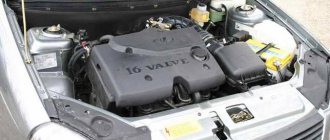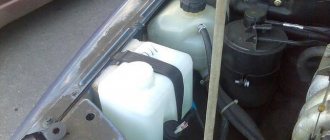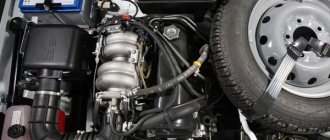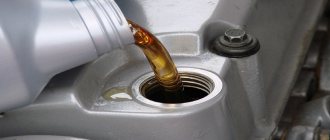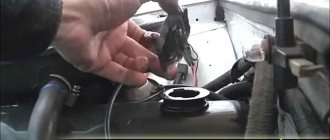In Chevrolet NIVA cars, from 2006 to 2008, a power unit from Opel was installed; today it is replaced by an engine from the VAZ-21214, improved to meet modern requirements, called 2123. Changes in the new modification affected many elements, thanks to which the engine’s operation became much quieter and more efficient.
Criteria for selecting VAZ 2123 oil
All oils are selected based on compliance with SAE, ACEA, API. In terms of composition, it is optimal to use semi-synthetics for used VAZs.
- ACEA A3/B3-B4.
- API SL, SM, SN.
At the pre-production stage (1998-2002) it was produced as the VAZ-2123 Niva, then as the Chevrolet Niva. The car is still being assembled to this day.
AvtoVAZ offers the following table to select the appropriate viscosity:
| Minimum engine cold start temperature, °C | Viscosity grade according to SAE J 300 | Maximum ambient temperature, °C |
| -35 | 0W-30 | 25 |
| -35 | 0W-40 | 30 |
| -30 | 5W-30 | 25 |
| -30 | 5W-40 | 35 |
| -25 | 10W-30 | 25 |
| -25 | 10W-40 | 35 |
| -20 | 15W-40 | 45 |
| -15 | 20W-40 | 45 |
But most often drivers fill in with 5w-40.
Information on viscosity for a specific engine can be found in the motor oil interchangeability catalog: https://www.northsealubricants.com/en/oil-advisor
The catalog can be trusted, the data is taken from car manufacturers. In this case, you can choose not only oil for the engine, but also for the gearbox, power steering, brake system, and cooling system. That is, all liquids.
Original LADA oils
#1
LADA PROFESSIONAL 5W-40
Best price Yandex Market
#2
Lada Ultra 5W-40 API SN/CF
Best price Yandex Market
The supplier of original oils for AvtoVAZ is the Rosneft company, so branded oils can be replaced by any product from this manufacturer that meets the specifications.
How much oil should there be in a Niva Chevrolet engine?
A 4-liter container should be enough to change engine oil
Like every car owner, those who drive a Niva must unconditionally accept regulatory data from the manufacturer.
The instruction manual for the 1.7-liter VAZ-21213 engine clearly states the maximum volume of engine oil - 3.75 liters . It should be taken into account that about 250 ml always remains in the oil filter.
Therefore, if you do not change the filter, the total volume of oil in this engine will be about three and a half liters .
If there are breakdowns in the engine, the oil volume will increase.
It is worth considering that this is the full volume of oil, and if during replacement more lubricant leaks into the container, there is reason to think about serious malfunctions. When checking the oil level with a dipstick, it is also worth considering that the oil volume between the “minimum” and “maximum” notches will be from 800 to 950 ml.
What oil consumption is considered normal?
The oil consumption of a run-in engine, according to factory standards, is 500 ml per thousand kilometers.
It is advisable to measure engine oil consumption at the same place where oil was last filled.
For comparison, in old VAZ cars of any model, the oil consumption rate was 0.4 liters. per 1000 km. As a rule, after proper engine running-in, oil consumption drops to 300-350 ml . True, this is the case when there are no visible leaks and the oil does not enter the combustion chamber, and there is no bluish smoke.
The crankcase protective boot can hide oil leaks from the engine.
It should be taken into account that the Niva Chevrolet has a protective crankcase boot with a layer of noise-preventing material, so if there is a leak, the oil can easily be absorbed into the material and the leak cannot be detected with the naked eye.
And one more thing - all oil level measurements must be done correctly, then the consumption readings will be as objective as possible.
Therefore, 3.75 l. - this is exactly the middle between the two notches on the dipstick, this is the normal level of lubrication.
Oil selection table by season (winter, summer)
| Year | Viscosity SAE all season from +25 to -25 °C | winter from -35 to 0 °C | summer from 0 to +35 °C |
| 5W-30 5W-40 | 20W-40 20W-30 25W-30 |
| 5W-30 5W-40 | 20W-40 20W-30 25W-30 |
| 5W-20 5W-30 5W-40 | 20W-40 20W-30 25W-30 25W-40 |
| 5W-20 5W-30 5W-40 | 20W-40 20W-30 25W-30 25W-40 |
Preparing for replacement
In addition to purchasing oil in sufficient quantities, before you begin to change it yourself, it is important to prepare all the materials and tools necessary for this procedure. In parallel with replacing the lubricant in the internal combustion engine, according to the regulations, a change of the filter element is required. This consumable part must be purchased exclusively of the original type to ensure reliable filtration during engine operation. Depending on the modification of the internal combustion engine, different oil filters will be required, therefore this element must be selected exclusively in accordance with the information in the technical data sheet, according to the original Niva Chevrolet consumables catalog. It is advisable to make such a purchase at official points of sale.
Additionally, to perform the work you will need the following tools:
- a set of car keys;
- special wrench for unscrewing the oil filter;
- extension for keys;
- container for waste liquid;
- clean rags.
You will have to work on a warm engine, so prepare protective clothing.
Recommended services for selecting automobile oils
If you already have preferences in the brand, then everything is even simpler. It is enough to go to any service for selecting automobile oils of the desired brand and the manufacturer will select the oil that will be compatible with your engine. The table contains the most popular brands and selection services from these brands. We go to any of the sites in the table and select the make, model of the car, engine and year of manufacture.
| Oil brand | Link to selection |
| LUKOIL | lukoil-masla.ru |
| Rosneft | rosneft-lubricants.ru |
| G-Energy | new.g-energy.org/ru |
| Gazpromneft | gazpromneft-oil.ru |
| GT OIL | gtoil.ru |
| Mobile | mobiloil.com.ru |
| SHELL | www.shell.com.ru |
| Motul | mymotul.ru |
| Castrol | applications.castrol.com |
| Kixx | kixxlube.ru |
| Lotos | lotosrf.ru |
| TOTAL | www.total-lub.ru |
| Liqui Moly | liquimoly.ru |
| Xado | xado.ru |
| ZIC | zicoil.ru |
| Valvoline | www.valvoline.com |
| TNK | www.tnk-oilcity.ru |
Oil change regulations and consumption rates
General Motors recommends changing the oil on a Chevrolet Niva at least once every 15,000 km.
Taking into account the difficult road conditions, the poor quality of fuels and lubricants in the regions and the strong variation in the quality of air and oil filters, experts recommend replacing them twice as often - once every 6-7 thousand mileage . This is a guarantee that the engine life will not be affected by the quality of fuels and lubricants and consumables.
Let your engine work long and economically and good roads to everyone!
Types of oils
At the end of the article, we will highlight three types of the most common lubricants for modern machines:
- Synthetic is the best motor oil. Considering its outstanding non-stick, anti-oxidation and anti-corrosion properties, this oil can be considered a standard compared to other types of lubricants. Synthetics are designed for a long service life and withstand difficult climatic conditions well. It can be used both in summer and winter. Due to its high degree of fluidity, such oil will never harden even at extremely low temperatures, which is an undeniable advantage, for example, compared to mineral oil.
- Mineral oil is the thickest oil, which because of this quickly hardens at low temperatures. Given this fact, this oil cannot be used in winter. In addition, it is better to use it with high mileage and in relatively warm climates.
- Semi-synthetic – consists of synthetic and mineral oils. There is much more mineral oil in semi-synthetics (70%). And yet, a semi-synthetic product is of much higher quality, it is better able to withstand low temperatures, and is thus more adapted to wide temperature ranges.
We can conclude that for the Chevrolet Niva, the semi-synthetic oil recommended by General Motors will be sufficient.
Frequency according to regulations
According to the regulations, the oil should be changed every 10,000 kilometers. If the car is not used very often and has low mileage, then the oil still needs to be changed at least once a year. In the following cases, an additional oil change may also be necessary:
- The engine starts very poorly at the start;
- The engine is running loudly and/or there is unusual noise;
- During movement, vibrations begin to occur;
- The lubricant level has dropped sharply;
- Upon inspection, traces of dirt and/or sand were found in the oil;
- The main fuel contains a large amount of sulfur.
Determining the level
Before refueling, it is recommended to determine the oil level in the car:
1. Open the hood and find the inspection hole - there you will see a dipstick for measuring the oil level in the engine (it is located in the middle of the cylinder block on the breather cover of the crankcase ventilation system);
2. Remove the dipstick and wipe it with a cloth to remove any remaining oil;
3. Insert the dipstick back, and after 5-10 seconds, remove it again - normally the oil should be between o and “MAX”.
When to check the oil in advance
At first glance, the established oil change schedule for the Chevrolet Niva may seem optimal. Indeed, in this regulation, the manufacturer took into account all the unfavorable factors that a Russian motorist may encounter.
Still, you should not rely solely on the data provided in the instruction manual. So, when servicing yourself, it is advisable to check the condition of the oil yourself from time to time. In addition, the unsuitability of the oil can be indirectly determined not only by its condition, but also by detecting the following signs:
- Increased fuel consumption
- Increased oil consumption
- The engine is running at partial power
- The engine is not able to develop high speeds
- High level of noise and vibrations
- When changing to the next gear, there may be a delay in shifting
Step-by-step replacement instructions
Required Tools
You will need the following supplies, parts and tools:
- New filter and oil;
- L-shaped hexagon;
- Container for draining old fluid (volume - at least 4 liters);
- Rags or rags.
Work order
1. Place the car on a lift, inspection ditch or overpass; 2. Start the engine, warm it up to operating temperature and turn it off after 10-15 minutes; 3. Open the hood and remove the oil filler cap by turning it 90 degrees counterclockwise; 4. Using rags or rags, clean the drain from any dirt that has accumulated there; 5. Remove the engine splash guard and crankcase protection. 6. Remove dirt from the drain plug using a wire brush, and then wipe the oil filter with a rag; 7. Using a hexagon, unscrew the drain plug and immediately replace the container;
Attention! Be very careful, the oil will be hot.
8. Wait 10-15 minutes for the oil to drain completely; 9. Unscrew the old oil filter, you may be able to do this by hand, otherwise you will have to use a special puller; 10. Take a new filter and fill it 60-70% with oil so that when you first start the engine runs for a minimum amount of time in oil starvation mode; 11. Lubricate the rubber ring on the filter with oil and screw it into place; 12. Tighten the drain plug and fill in clean oil, monitoring its level (remember that the recommended standards are 3.5-3.7 l); 13. Start the engine and make sure that the oil pressure sensor goes out; 14. Let the engine idle for 10-15 minutes; 15. Inspect the oil filter and make sure there are no leaks.
“Comrade, demand full filling” is a famous Soviet slogan, although it did not apply to motor oil. Regarding the Niva Chevrolet car, the volume of oil in the engine must be kept exclusively within normal limits and carefully monitored. At the slightest leaks and minimal underfills, the driver must take emergency measures. Let's look at the standards, volumes and allowable consumption of motor oil for the Chevrolet Niva right now.
The best motor oil. does it exist?
Related posts:
Choosing engine oil is a responsible task on which the service life of the power plant depends. This procedure is no less important than the oil change process itself. Oil should be selected according to the parameters and tolerances specified in the operating instructions. You cannot make a mistake in your choice, as this mistake can result in a serious technical breakdown, and incompatible oil can cause a major overhaul of the engine. In this article, using the example of the popular Chevrolet Niva SUV, we will pay attention to the most important parameters of motor oil, and also consider the best brands of oils and how much oil should be filled.
What is recommended for use
The correct selection of engine oil is based primarily on determining its operating conditions, both climatic and power influences on the car engine. Based on these principles of approach to the requirements for lubricating fluids, the Chevrolet Niva car engine will work better on oils:
- from SHELL - Helix Plus, Helix Plus Extra, Ultra. The use of these oils allows to reduce friction of the contacting surfaces of the engine. This leads to economical operation, lower fuel consumption and increased vehicle power;
Shell synthetic motor oil for high performance engines
- from Castrol – Magnatec of various modifications (depending on operating conditions). Good energy saving function, excellent protective characteristics, perfectly washes engine parts, does not allow small suspended particles to settle on them;
Synthetic engine oil ensures perfect engine operation
- products from Exxon Mobil Corporation - ensure reliable operation of the engine, its durability, reduce fuel consumption, carefully monitor the cleanliness of the engine and its wear resistance;
Mobil 1 engine oil - and your engine runs flawlessly at any temperature
- from the German manufacturer Ravenol TSI. The oil has a fairly long service life and good ability to wash engine parts; at a price, it has an attractive purchasing power. But it’s worth mentioning that this liquid has a low coefficient of energy-saving functions;
Easy-to-flow synthetic oil provides extended service life of the Chevrolet Niva engine between oil change intervals.
- ZIC XQ oil from South Korean SK Lubricants will withstand the most severe operating conditions of the Niva. The operating temperature conditions of this lubricant are an order of magnitude higher than those of similar oils from other manufacturers. Remarkable protective and cleaning properties, sensitive economic components of oil use (energy-saving functions, accessibility);
Motor oil from the largest manufacturer with reduced phosphorus, sulfated ash and sulfur content
- Lukoil Lux from LLC LLK-International. Oil brands must be optimally selected for the operating conditions of the vehicle;
Synthetic all season motor oil
- oil from Rosneft Premium. This lubricating fluid has decent performance, both in temperature conditions and in the operational properties of the Chevrolet Niva power unit.
Universal synthetic motor oil with added additives allows you to easily start the engine both at + 35°C and at -35°C. Carefully cares for the internal parts of the engine
Reservoir for windshield and brake fluid.
Another filling capacity of the Chevrolet Niva is two glass washer reservoirs, the capacity of which is five and two liters.
This model has two independent braking systems. The working one has a hydraulic drive, the parking one has a mechanical drive. The contours are separated from each other.
The hydraulic drive includes a special tank made for brake fluid.
- DOT-4 brake fluid is suitable for half-liter hydraulic brakes. The product has improved characteristics and has a boiling point of over 235 degrees. Well suited for regions with low ambient temperatures.
- SAEJ1703, FMSS116 are used for the entire hydraulic system and clutch release (0.15 l). The synthetic product provides good lubrication and reduces oxidation at high temperatures.
- The tank lid hatch hinges, door and hood locks require VTV-1 and FIOL-1 greases. Hinges of steering rods and cardan shafts - ShRB-4, Litin 2, Esma.
- The air conditioner also has two tanks. One of them is for oil (0.22 l), the other is for refrigerant (0.650 kg).
Chevrolet Niva reservoirs for refilling liquids and lubricants are quite reliable and convenient when you need to make a replacement.
Various tags and sensors make it possible to carry out control almost immediately, which allows you to avoid an emergency situation.

